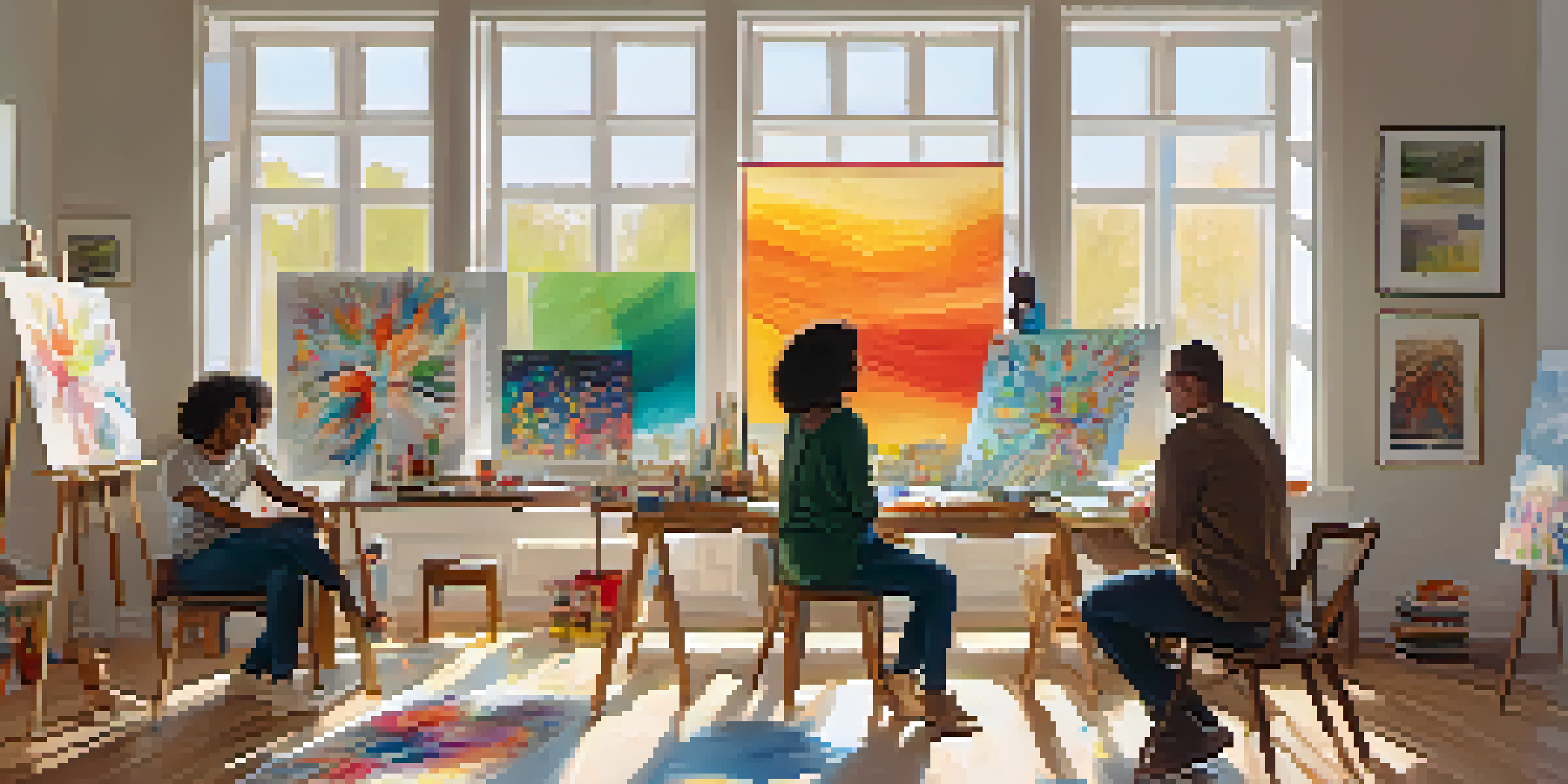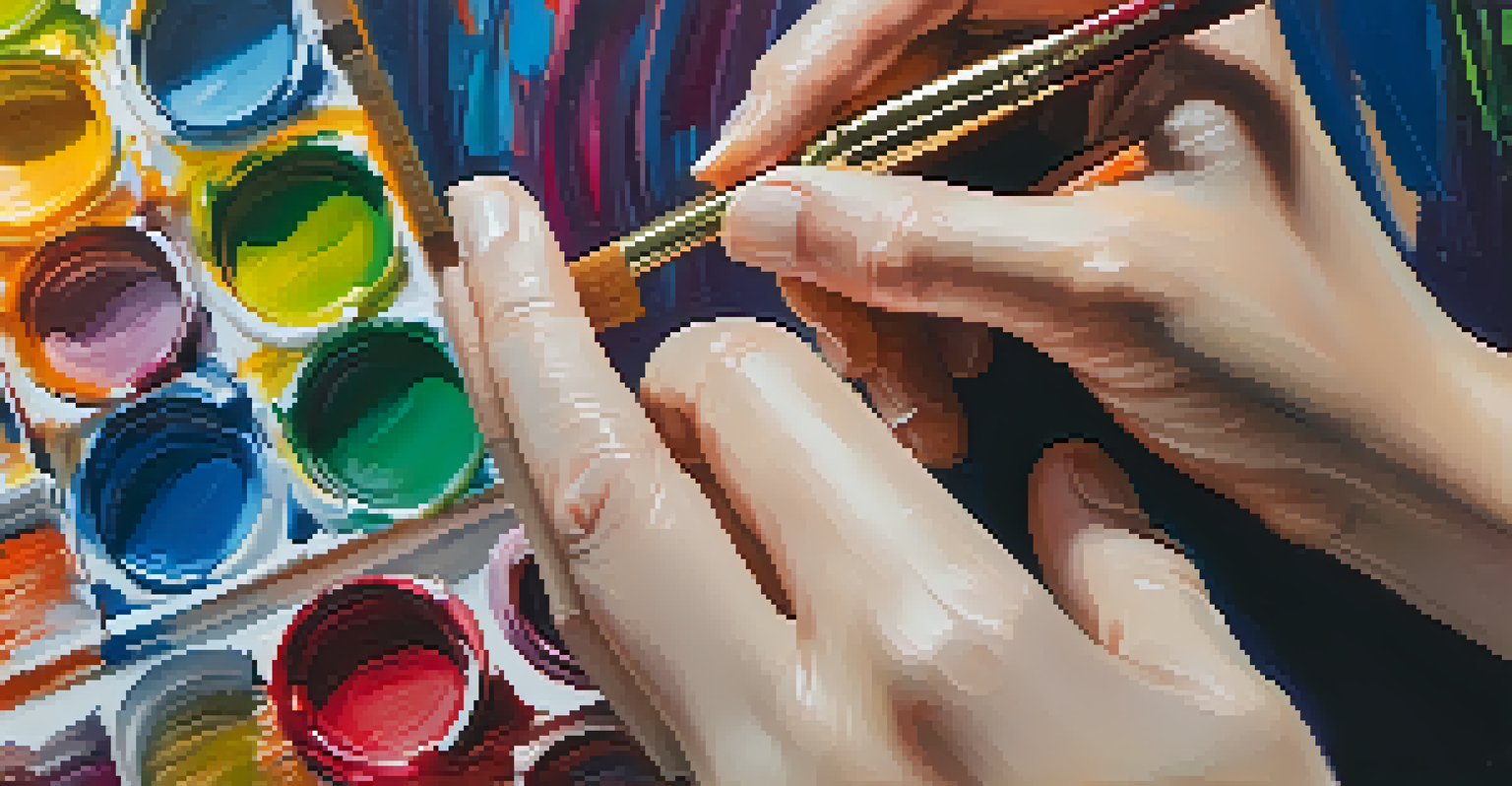Marijuana as a Catalyst for Creative Exploration in Art Therapy

Understanding Art Therapy and Its Benefits
Art therapy combines creative expression with psychological support, allowing individuals to communicate feelings they might struggle to articulate. This therapeutic approach not only fosters emotional healing but also enhances self-discovery and personal growth. By using various art forms, clients can explore their inner thoughts and connect more deeply with their emotions.
Art is not what you see, but what you make others see.
The benefits of art therapy extend to various populations, including those dealing with trauma, anxiety, and depression. It provides a safe space for individuals to express themselves without judgment, promoting a sense of autonomy and empowerment. Moreover, the act of creating art can be meditative, helping to reduce stress and foster relaxation.
As we explore art therapy, it's essential to consider how different influences can enhance the experience. One such influence that has gained attention is the use of marijuana, which some believe can unlock new avenues of creativity and expression.
Marijuana's Historical Connection to Creativity
For centuries, marijuana has been linked to creative exploration across various cultures. Artists, musicians, and writers often cite the plant as a source of inspiration, claiming it helps them break down mental barriers. This historical context sets the stage for understanding its potential role in modern art therapy practices.

Famous figures like Pablo Picasso and Louis Armstrong have openly discussed how marijuana influenced their creative processes. They found that the substance helped them think outside the box and explore new ideas that might not have surfaced otherwise. This anecdotal evidence suggests a strong relationship between marijuana and artistic innovation.
Art Therapy Enhances Emotional Healing
Art therapy provides a creative outlet for individuals to express feelings and foster personal growth.
While it may not be a universal experience, many individuals report feeling more open and imaginative under the influence of marijuana. This heightened sense of creativity can be particularly beneficial in therapeutic settings, where breaking free from conventional thought patterns is often necessary.
The Science Behind Marijuana and Creativity
Research into marijuana's effects on the brain indicates that it can alter perception and enhance sensory experiences. This alteration may lead to a more profound appreciation of colors, sounds, and textures, which can be particularly beneficial in art therapy. By engaging the senses, clients may find themselves more inspired to create.
Creativity takes courage.
Cannabinoids, the active compounds in marijuana, interact with the brain's endocannabinoid system, which plays a role in mood regulation and pleasure. This interaction can lead to feelings of euphoria and relaxation, creating an optimal environment for creative exploration. In such a state, individuals may feel more liberated to express their thoughts and emotions through art.
However, it's important to approach this topic with balance. While marijuana may catalyze creativity for some, its effects can vary greatly from person to person. Understanding these nuances is crucial in determining how to best integrate marijuana into art therapy sessions.
Marijuana as a Tool in Art Therapy: Benefits
When used responsibly, marijuana can serve as a valuable tool in art therapy, encouraging clients to explore their creativity more freely. Many therapists have noted that clients who use marijuana experience reduced inhibitions, allowing for a more authentic artistic expression. This can lead to breakthroughs in therapy, helping clients confront and process difficult emotions.
The calming effects of marijuana can also enhance focus and concentration, enabling clients to immerse themselves in their artwork. This heightened state of awareness can facilitate deeper connections with the creative process, making it easier to express complex feelings visually. As a result, art therapy sessions can become more impactful and transformative.
Marijuana Can Boost Creativity
The use of marijuana may help individuals break down mental barriers, leading to increased creative expression during art therapy.
Moreover, incorporating marijuana into art therapy can foster a sense of community among participants. Clients may feel more comfortable sharing their experiences and insights, leading to richer discussions and connections with others in the therapeutic space.
Challenges and Considerations in Using Marijuana
While the potential benefits of using marijuana in art therapy are compelling, there are challenges and considerations to keep in mind. Not everyone responds positively to marijuana, and some individuals may experience anxiety or paranoia. It's crucial for therapists to assess each client's comfort level and history with marijuana before integrating it into therapeutic practices.
Additionally, the legal status of marijuana varies widely across regions, which can impact the ability to use it in therapy. Therapists must navigate these legal landscapes carefully and ensure compliance with local regulations. This adds an extra layer of complexity to the integration of marijuana in art therapy settings.
Finally, it’s essential to maintain a balanced perspective. While marijuana can enhance creativity for some, it should not be viewed as a magic solution for all artistic blocks. Encouraging clients to explore various methods of creative expression, regardless of substance use, is vital for holistic growth.
Real-Life Examples of Marijuana in Art Therapy
There are numerous anecdotal accounts of art therapists successfully incorporating marijuana into their sessions. For instance, a therapist in California found that clients who used marijuana during art therapy were more willing to take risks with their artwork. This led to more vibrant and emotionally charged pieces, showcasing the potential for deeper self-exploration.
Another example involves a group therapy session where participants were allowed to use marijuana before engaging in collaborative art projects. The results were remarkable; participants expressed feelings of unity and shared understanding, which enriched the creative process. This demonstrates how marijuana can foster connections among individuals, enhancing the therapeutic experience.
Considerations for Using Marijuana
While marijuana can enhance the therapeutic process, its effects vary by individual, necessitating careful assessment and adherence to legal guidelines.
These real-life examples highlight the transformative power of integrating marijuana into art therapy. However, they also underline the importance of responsible use and individualized approaches tailored to each client's needs.
Future Directions for Marijuana and Art Therapy
As society's perception of marijuana continues to evolve, so does its potential role in therapeutic practices like art therapy. Ongoing research will likely shed more light on the benefits and risks associated with using marijuana in creative settings. This could lead to more structured guidelines for therapists interested in exploring this approach.
Moreover, as more states legalize marijuana, therapists may have greater opportunities to incorporate it into their practices. This opens up new avenues for creative exploration and innovation in art therapy, allowing for a more diverse range of therapeutic techniques. The future could see more workshops and training programs focusing on the integration of marijuana into art therapy.

Ultimately, the goal is to find ways to enhance the therapeutic experience for clients. By remaining open to new ideas and approaches, therapists can create more engaging and impactful art therapy sessions. The journey of exploration in this field is just beginning, and its potential is vast.